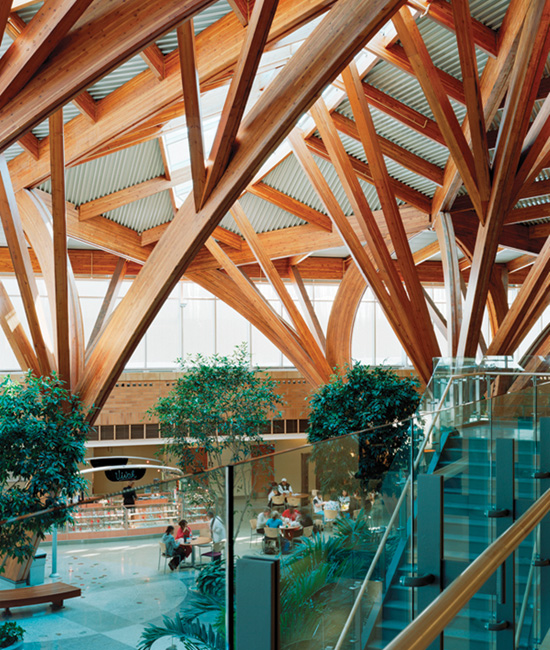Wood and Indoor Environment
Health in Nature
The definition of sustainable building continues to deepen as we understand more about the impact of buildings on the environment and on people. One of the most promising areas of focus is “evidence-based design,” which involves using information gained from the rigorous analysis of past buildings to build better new ones. Healthcare architects have been at the forefront of this effort, exploring the physiological benefits of good design on patient recovery and the well-being of staff and visitors. Among the results, an increasing number of healthcare facilities are making use of natural daylight, views of nature, and exposed wood to create a warm, natural aesthetic that supports their healing objectives. These same techniques are also being used in schools and offices to improve performance, productivity, and occupant well-being.
Humans have a natural affinity for nature. Being in a natural environment—a forest, park or garden—can make us feel more relaxed. The term “biophilia' has been coined to refer to this phenomenon. Although most of us understand the connection intuitively, the stress-reducing effects of outdoor nature are also well documented from a scientific perspective. Exposure to nature has been shown to lower blood pressure, heart rate, and aggression. Nature also increases the ability to focus attention and perform concentration and creative tasks. One landmark study of hospital patients recovering from abdominal surgery found that patients in rooms with a view to nature had shorter post-operative hospital stays and required fewer analgesics than patients with a view of another building from their window.1

Photo by Peter Sellar, Tye Farrow of Farrow Partnership, courtesy of naturallywood.com
Credit Valley Hospital in Mississauga, Ontario, is one of an increasing number of healthcare facilities making use of exposed wood to create a warm, natural aesthetic that supports their healing objectives.
But what about the “average North American” spending 90 percent of the time indoors? In addition to views of nature itself, there is growing evidence that a positive relationship exists between humans and natural materials.
For example, a 2012 study at the University of British Columbia and FPInnovations demonstrated that the presence of visual wood surfaces in a room lowered sympathetic nervous system (SNS) activation. The SNS is responsible for physiological stress responses in humans.
In the study, four office environments were created to examine the effects of natural materials on autonomic nervous system responses. The rooms were identical except for either wood finishes (birch veneer) or white finishes, and the placement of either plants or non-natural objects. Stress as measured by SNS activation was lower in the wood room in all periods of the study. Temporary spikes in skin conductivity (associated with stressful thoughts or stimuli) were also measured. Once again, the subjects in the wood room had statistically fewer of these responses, interpreted as fewer stressful thoughts.
Building on this study, the 2015 report, Wood as a Restorative Material in Healthcare Environments,2 reviews available research on the human response to natural elements in the built environment, concluding that it is reasonable and desirable to employ more wood in healthcare environments.
The report states: “In the small but growing volume of research on wood and health, the results that are emerging mirror results we have seen from exposure to other natural elements, such as views and plants. Lower stress reactivity in the autonomic nervous system is found when wood, plant, or nature views are present. Lower sympathetic activation and higher parasympathetic activation result in measurably lower heart rate, lower blood pressure, lower skin conductivity, and higher heart rate variability. These results have been linked to exposure to wood. However, lower stress activation due to views and plants have also been shown to increase the ability to concentrate, lower pain perception, and speed recovery times. Though these benefits have not been identified for wood, they are tied to the same automatic responses to nature seen with wood. Therefore, it is reasonable to expect that future research on wood will find many of these same results.”
The report goes on to say that, “In healthcare environments, natural materials and views are associated with better patient outcomes with respect to recovery times, lower pain perception, and positive dispositions. This alone is reason for including more wood in these buildings. However, healthcare facilities are populated not only by patients, but also their visiting families and the practitioners that treat them. These people also benefit from the pro-health effects of nature. […] Further, the link between natural elements and the ability to focus attention cannot be ignored for healthcare practitioners who work all hours and often do not have access to the benefits of natural light.”









